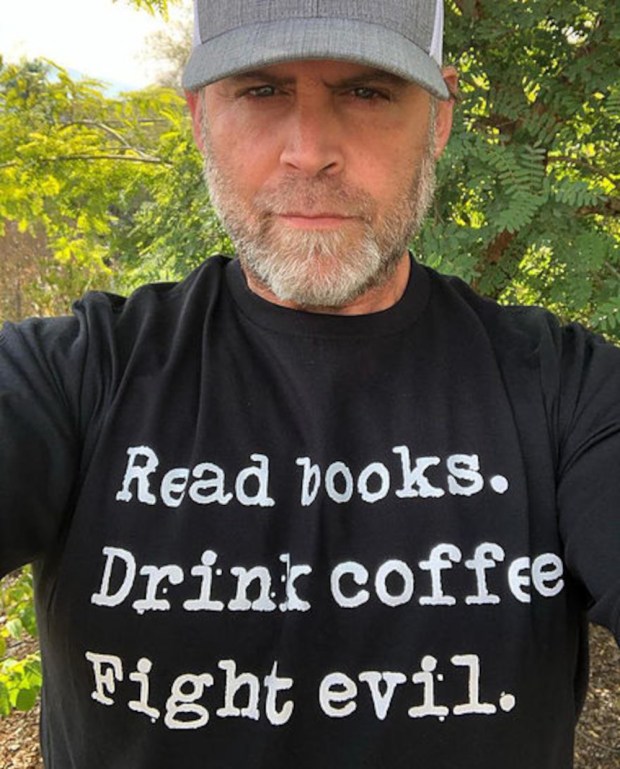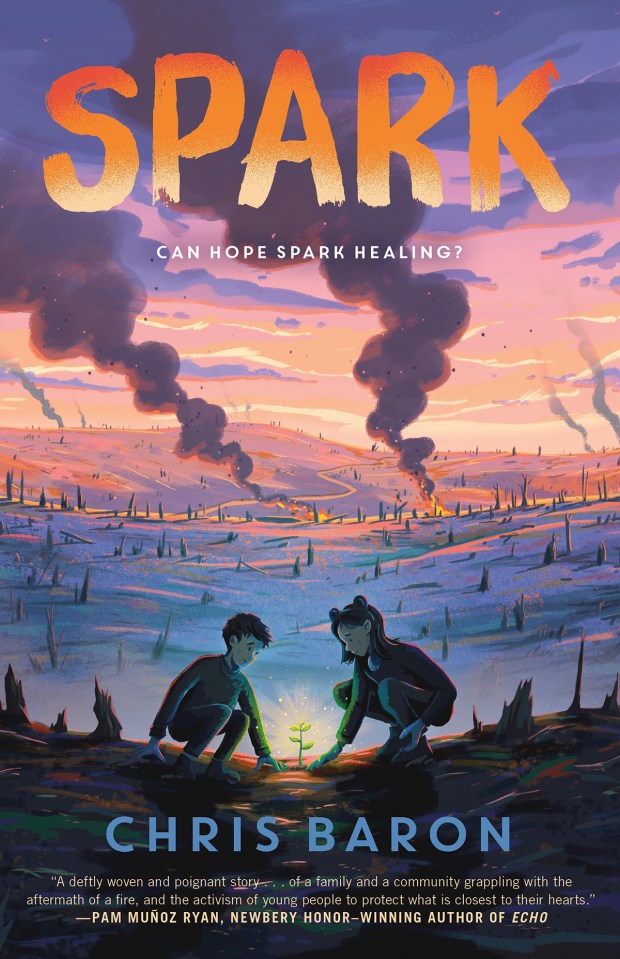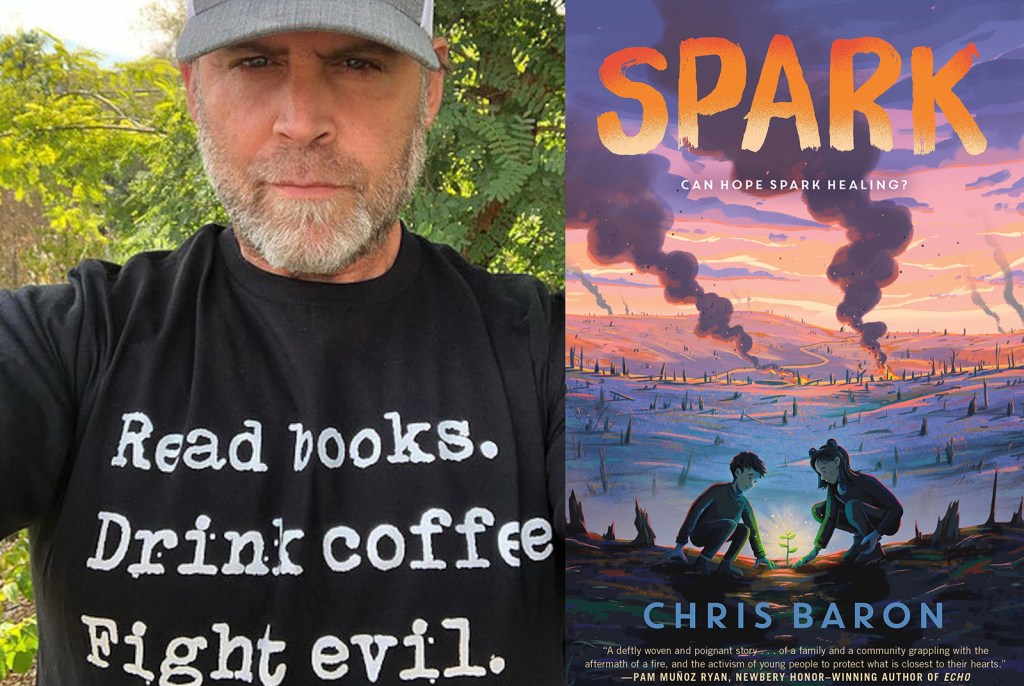Longtime San Diego author and college professor Chris Baron has often called on personal experiences and observations for the subjects of his novels for middle-grade and young adult readers.
But for his latest book, “Spark,” he drew inspiration from one of his family’s most harrowing experiences — being forced to evacuate their home as flames approached from the disastrous 2007 Witch Creek wildfire. But as challenging as that experience was, Baron said it offered important life lessons that he shares in “Spark.”
Baron grew up in New York City and graduated from San Diego State University with a master’s degree in poetry. He works as an English professor and the Writing Center director at San Diego City College. His novels for what he calls “young and young at heart” readers include the award-winning “The Magical Imperfect,” “The Gray,” “All of Me” and “The Secret of the Dragon Gems,” the last of which he co-wrote with Newbery Award-winning author Rajani LaRocca.
Baron, who lives in San Diego with his wife, Ella, their three kids and eight chickens, will discuss “Spark” at Warwick’s bookstore in La Jolla on Thursday. He recently answered several question about his book and its inspiration.
 San Diego author Chris Baron will discuss his latest book, “Spark,” at Warwick’s bookstore in La Jolla on Thursday. (Chris Baron)
San Diego author Chris Baron will discuss his latest book, “Spark,” at Warwick’s bookstore in La Jolla on Thursday. (Chris Baron)
Q: “Spark” is your fifth novel for young adult (YA) and middle-grade readers. What inspired you to write books for these reading age groups and why do you think it’s important to write for young growing minds?
A: I’ve always loved stories, and spent so much time playing, writing and exploring stories of my own. Stories shape our world. Books give us time and space to explore and move through a story at a slower pace (even when we read fast). A good story stays with us forever. But when my kids were old enough, they wanted to hear every tale about my childhood, read every book, and tell stories of their own. It clicked for me then, maybe I could write some stories related to my own experiences that could reach all kinds of readers.
YA and middle-grade books are lighthouses for empathy, adventure and exploration. Middle grade and YA changed my life as a kid. They allowed me to escape from a challenging world of growing up into imagination, explore the world and find hope. Comic books, graphic novels and books like “Bridge to Terabithia” and “The Lord of the Rings,” and everything by Judy Blume helped me to understand I wasn’t alone and connect to the world around me.
Q: The young characters in your previous novels have faced personal, physical and emotional challenges. How do you develop the traits and personalities for the characters in your books?
A: Even in the best parts of our lives, we all face different kinds of challenges — we are all outcasts one way or another. So much of what I write comes from my own experiences and the experiences of those around me: my Jewish heritage, the places where I grew up, and the friends I’ve known. Some of the characters come from my own life, like the way Sasha struggles with anxiety in “The Gray,” or Etan’s selective mutism and Malia’s eczema (like my wife struggles with) in “The Magical Imperfect,” or issues of body image in “All of Me.” But also from the lives of the students I’ve known, and of course, the ever-changing world of my own family.
I just know that I want my characters to be, as Dr Rudine Sims Bishop said, “windows and mirrors, and sliding glass doors” to help young readers see themselves in books and learn about the diverse and often atypical lives of the people around them.
Q: You said “Spark” was inspired by your own experience fleeing the Witch Creek Fire in 2007. Can you explain the emotional toll that took on you and your family and how it inspired “Spark”?
A: Ella and I were living in Ocean Beach and when our second daughter was born, we hoped for a house where we could grow things and have a backyard. We found Mt. Helix, and an old “fixer upper.” We worked on it endlessly, and finally it was ready, right after our daughter was born. We moved into the house — but the skies were orange and filled with ash from the fallout from the Witch Creek Fire. Surely, we thought, it can’t last much longer. We were wrong.
One of the first mornings we were there, we woke up, and from across the valley we saw a snake of fire writhing down Mt. Miguel just a few miles away. We had to go. We fled back to Ocean Beach, prayed and waited even as the ash floated all the way to the ocean and covered the beach. It felt like the whole world was on fire. Months later, we eventually moved in, and we love where we live, but there is always that sense that anything can happen. So many people since, like the residents in Plumas County (Where the book is based) and beyond, know this fate. I also recognize that this kind of trauma of evacuation goes beyond just fire.
These experiences, along with a deep love of the natural world, are a direct inspiration for writing “Spark.” Like so many San Diego residents, I understand the fear that comes with Santa Ana winds. We have empathy for L.A. and so many parts of the world that are experiencing the devastating effects of wildfire. But I know there’s hope for the future, I’ve seen and been part of, first-hand, the hope and heart of community.
Q: Please describe the two friends at the heart of “Spark,” Finn and Rabbit, who are separated after a wildfire arrives in their community, and how the fire affects their lives and families?
A: Finn, the great-grandson of Jewish immigrants who came to the United States to plant new and safe roots, lives with his mom and dad. His best friend, Rabbit, is from a giant family — her dad is from Texas and mom is from the Philippines. Luckily, their families found the beautiful small town in the mountains, Redwood Hollows.
They have been best friends since they were little, both of them care deeply about nature and love to spend their days in the forest near the home, setting up trail cameras like windows into the natural world searching for any rumor of the wolves that may have returned to their forest. Rabbit, full of passion, independence, and wildness, likes to say she’s the “heart” and Finn, intellectually curious, scientific, overly focused, is “the mind. But together, along with Rabbit’s dog, Thorn, make a great team.
When the emergency alert sounds, and the fire actually strikes their town, they are separated and rush to escape, unaware of what happened to the other for quite some time — and like so many people from their community, they must live evacuated, uprooted, far from everything they know trying to piece together some semblance of normal life until it’s safe to return.
Q: Southern California’s growing problem of wildfires, including the recent fires in Los Angeles, are the unfortunate result of global warming. Do you address the issue of climate change in “Spark”?
A: At the heart of “Spark,” just like the heart of our world, is the changing climate. Finn and Rabbit discover first hand, with Rabbit’s scientist uncle Charlie, the devastating impact of drought, uneven weather, the wildland urban interface, and species adaptation. I spent over a year researching and interviewing wildland ecologists, forest service workers and scientists, wildland firefighters, Indigenous tribal liaisons, wildlife experts and others, to truly bring as much about the issue of changing climate to “Spark” as possible while integrating the hope and voice of the community.
Q: Although fire can be devastating for people and wildlife, nature eventually recovers. Can you talk about the importance of hope and community in “Spark”?
A: Yes! Given time and space, the resilience and recovery of our natural world is miraculous and full of wonder! I think so many young readers want to know what they can do against something so big and chaotic as a wildfire or climate change in general. But I’ve found that the real hope is in them. Young people are unafraid, ready for change, courageous and curious. In “Spark,” the kids discover the resilience of nature, learn about regrowth and the strength of the land. They find a way to kick-start their own activism to help save the forest for now and generations to come — and it begins with the simplest thing — an acorn.
Q: Is there anything I haven’t asked about “Spark” that you’d like to add?
A: My deep wish is that “Spark” becomes a resource for empathy and understanding for readers — a book that can be read as a family, in classrooms and book clubs, and talked about in community, and I will do all I can to visit those places and be available to talk to readers!
 The book cover for “Spark” by Chris Baron. (Feiwel & Friends)
The book cover for “Spark” by Chris Baron. (Feiwel & Friends)
“Spark” by Chris Baron (Feiwel & Friends, 2025; 320 pages)
Warwick’s Presents Chris Baron
When: 7:30 p.m. Thursday
Where: Warwick’s bookstore, 7812 Girard Ave., La Jolla
Admission: Free, but $19.99 with tax buys a book and a reserved seat
Reservations: warwicks.com/event/baron-2025
